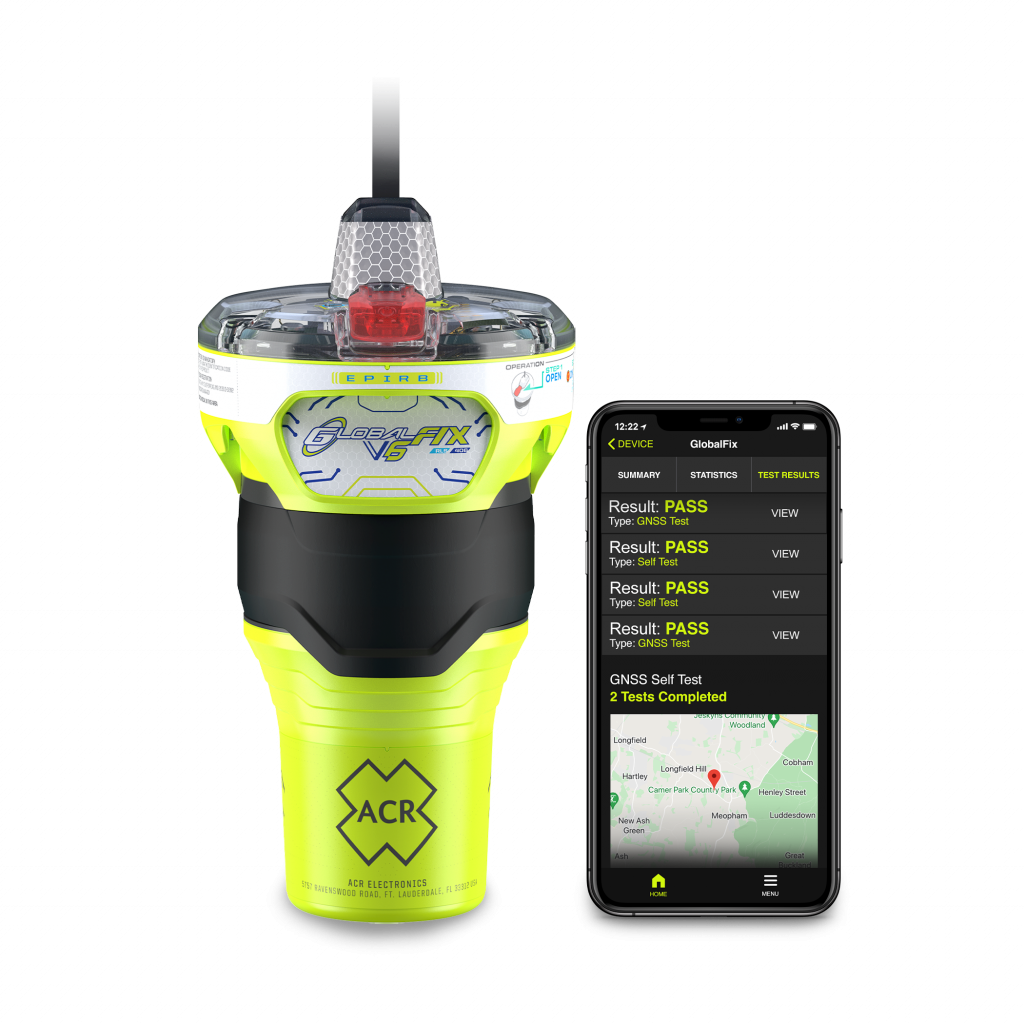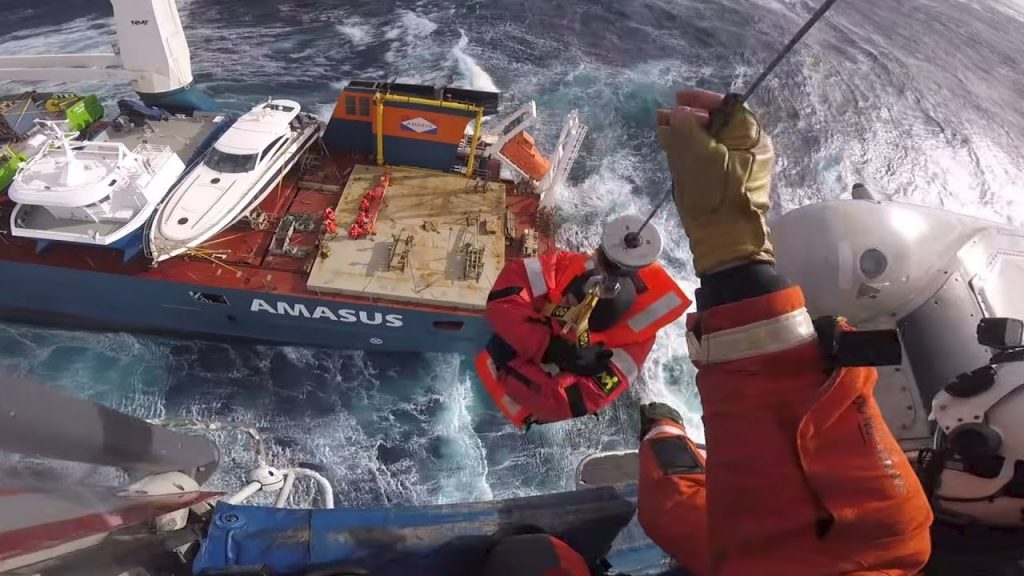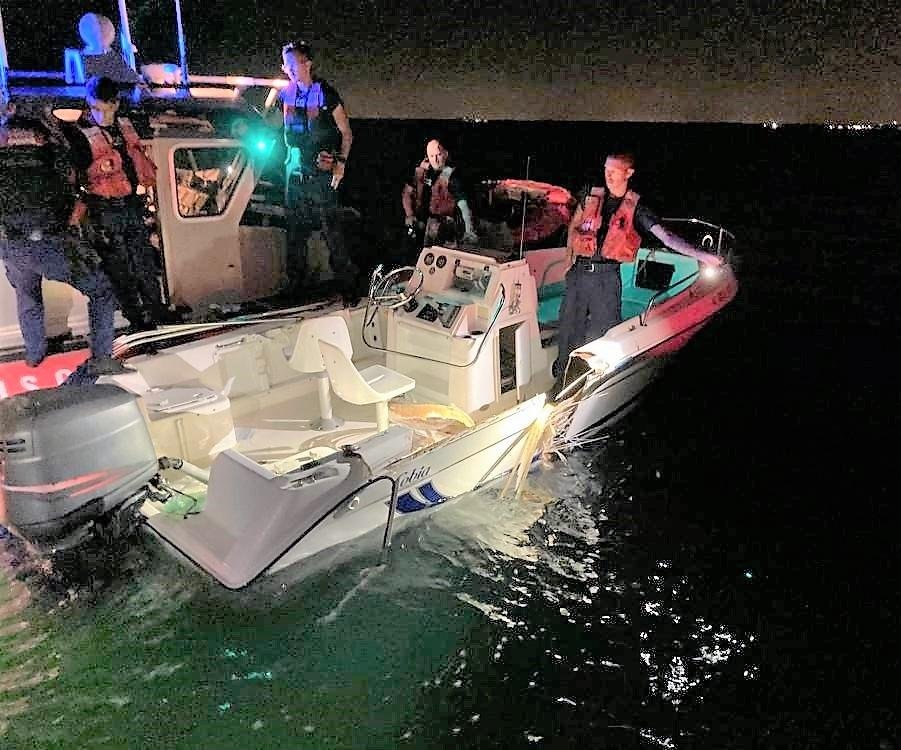EPIRB: Essential Guide to Maritime Distress Beacons
An Emergency Position Indicating Radio Beacon (EPIRB) is an essential safety device for both commercial and recreational marine vessels. In the event of an emergency, such as a ship sinking or medical incident onboard, EPIRBs transmit distress signals to alert search and rescue teams to the vessel's position and facilitate a swift response. EPIRBs are designed to provide a lifeline by sending out location data via satellite networks when activated, ensuring the chances of a successful rescue operation are maximized.

With the primary goal of saving lives in maritime emergencies, EPIRBs have become a crucial piece of equipment for boaters worldwide. These devices are designed to withstand harsh conditions and are built to float free from a sinking vessel or be activated manually. Upon activation, an EPIRB sends out a distress signal that includes the vessel's unique identification number, the nature of the distress, the emergency contact information, and the precise location of the beacon. These signals are crucial for coordinating search and rescue operations, as they provide valuable information to first responders.
Key Takeaways
- EPIRBs are vital safety devices for marine vessels, transmitting distress signals during emergencies.
- Upon activation, an EPIRB sends crucial information to aid search and rescue teams.
- Proper EPIRB registration and maintenance are essential to ensure effectiveness during emergencies.
Emergency position-indicating radiobeacon

Understanding EPIRBs
Basics of EPIRB
Emergency Position Indicating Radio Beacons, or EPIRBs, are essential devices for emergency situations at sea. EPIRBs alert search and rescue services (SAR) by transmitting a signal on a specified frequency, helping to locate lifeboats, life rafts, ships, or individuals in distress [source]. These beacons provide worldwide coverage, accurate position location, a reliable transmitted signal, an encoded message identifying the distressed vessel, and a faster response time [source]. EPIRBs commonly operate on two frequencies: 406 MHz and 121.5 MHz.
The 406 MHz frequency is specifically used by the COSPAS/SARSAT system of polar orbiting satellites, ensuring prompt and efficient global coverage. On the other hand, the 121.5 MHz frequency is utilized for final homing and location purposes by search and rescue crews, giving rescuers precise coordinates for rapid assistance [source].

Types of EPIRBs: Category I and II
EPIRBs are available in two main types, Category I and Category II:
- Category I EPIRBs are float-free and automatically activated devices [source]. They are designed to release from their housing and activate upon contact with water, ensuring they relay distress signals even if the vessel crew is unable to manually activate them.
- Category II EPIRBs are manually activated beacons that require the user to remove the device from its bracket and switch it on in case of an emergency.
Both Category I and Category II EPIRBs have the vital function of alerting SAR services to the location of a vessel in distress, helping to save lives during maritime emergencies.

Distress Signal Mechanism
Doppler Shift and GPS Receiver
Emergency Position Indicating Radio Beacons (EPIRB) are designed to send distress signals during emergencies at sea. Activated either manually or automatically when submerged in water, EPIRBs transmit signals at a frequency of 406 MHz, which is recognized internationally for search and rescue efforts source.
EPIRBs use a combination of Doppler shift and GPS technology to determine their location. When a distress signal is transmitted, it is picked up by earth-orbiting satellites which use the Doppler shift effect to calculate the beacon's position. Some EPIRBs are also equipped with GPS receivers that provide accurate location data to further enhance the search and rescue mission source.

Distress Alerting and Return Link Service
In addition to the initial distress signal, EPIRBs also transmit a digitally coded message that includes unique information about the vessel in distress, such as its identification number, type of emergency, and contact information for the owner source.
Once the distress signal and associated data are received by satellites, the information is forwarded to a ground station for verification. After verification, the ground station notifies a central command responsible for search and rescue operations, such as the Mission Control Center (MCC) source.
The Return Link Service is a supplementary feature that allows the central command to send a confirmation message back to the EPIRB, acknowledging that the distress alert has been received and help is on the way source. This additional communication provides reassurance to those in distress and allows rescuers to keep them informed throughout the search and rescue process.
Overall, the distress signal mechanism of EPIRBs, along with satellite systems and return link services, helps facilitate quick and precise response to emergencies at sea, saving lives and property.

Search and Rescue Operations
Role of U.S. Coast Guard
The U.S. Coast Guard plays a vital role in search and rescue (SAR) operations involving EPIRBs (Emergency Position Indicating Radio Beacons). When an EPIRB is activated, its signal is detected by earth-orbiting satellites and forwarded to a ground station for verification. The ground station then notifies the central command (MCC) to initiate search and rescue. The MCC coordinates with the U.S. Coast Guard or the Air Force Rescue Coordination Center (RCC) nearest to the boater's location, ensuring a timely and effective response to distress signals 1.
During SAR operations, the U.S. Coast Guard employs various assets, such as:
- Vessels
- Helicopters
- Airplanes
These assets, together with highly trained personnel, contribute to the successful execution of search and rescue missions, potentially saving lives and protecting people in distress 2.

Worldwide Coverage and COSPAS-SARSAT Program
EPIRBs benefit from the coverage and support provided by the international COSPAS-SARSAT program. This program is a satellite-based search and rescue system consisting of several countries collaborating and providing global SAR services. The COSPAS-SARSAT program has been saving lives since 1982, with over 50,000 people worldwide rescued thanks to carrying a 406 beacon as part of their survival gear 3.
The COSPAS-SARSAT satellite system provides:
- Global coverage
- Timely detection of distress signals
- Accurate location data for SAR providers
This comprehensive coverage enables efficient coordination among different SAR providers and rescue coordination centers (RCCs) across the globe, ultimately contributing to the success of search and rescue operations 4.
In summary, EPIRBs play a crucial role in search and rescue operations, with the support of organizations like the U.S. Coast Guard and the COSPAS-SARSAT program. These collaborations ensure timely and effective responses to distress situations, ultimately saving lives at sea.

Other Emergency Beacons
Besides EPIRBs, there are other emergency beacons that can offer additional safety measures in various distress situations. This section will focus on Personal Locator Beacons (PLBs) and Emergency Locator Transmitters (ELTs) as effective emergency communication tools.
Personal Locator Beacons
Personal Locator Beacons (PLBs) are smaller and more portable than EPIRBs. They work on the same principle of assisting search and rescue operations in case of emergencies. Designed for individual use, PLBs are suitable for hikers, climbers, and outdoor enthusiasts who venture into remote areas. When activated, a PLB sends a distress signal to the nearest search and rescue center, providing the user's exact location for a quicker response.
One of the main benefits of PLBs is their ability to be carried on a person's body, which increases the chances of successful rescue if an incident occurs. However, it is essential to remember that PLBs have a shorter battery life and a more limited range compared to EPIRBs.

Emergency Locator Transmitters
Emergency Locator Transmitters (ELTs) serve a similar purpose to EPIRBs and PLBs but are specifically designed for aircraft emergencies. Activated either manually or automatically during a crash, ELTs emit a distress signal to alert search and rescue teams about the aircraft's situation and location.
There are different types of ELTs based on their triggering mechanisms, such as:
- Automatic Fixed ELTs (AF ELTs): Mounted to the aircraft and automatically activated upon impact
- Automatic Portable ELTs (AP ELTs): Portable devices that can be attached to the aircraft and manually removed in case of emergency
- Manual/Survival ELTs (S ELTs): Hand-held devices that must be manually activated by the user
Both PLBs and ELTs leverage advanced satellite networks and technology to provide accurate location information during emergencies. It is crucial to maintain and test these devices regularly to ensure their functionality when needed.

Key EPIRB Features
Hydrostatic Release
Hydrostatic release is a critical feature found in many EPIRBs, designed to automatically activate the device upon being submerged in water, usually at a depth of 1.5 to 4 meters. This feature helps ensure a timely distress signal transmission in case of an emergency at sea, even if the crew is unable to activate the device manually. A hydrostatic release mechanism is a valuable addition to EPIRBs, increasing their effectiveness during maritime disasters.
Strobe Light and Retractable Antenna
In addition to their emergency radio signal transmission, many EPIRBs also feature a built-in strobe light, which aids in visually locating the device and distress survivors during search and rescue operations. The strobe light provides an essential visual signal that can help rescuers locate and reach the persons in distress more quickly, especially in low-light or nighttime conditions.
A retractable antenna is another feature found in modern EPIRBs. The antenna can be extended when the EPIRB is activated, improving the radio signal's strength and transmission range. A retractable antenna helps ensure that the distress signal is transmitted effectively, even during adverse weather conditions or other situations where signal transmission might be compromised.
EPIRBs with these key features, such as hydrostatic release, strobe light, and retractable antenna, enhance the effectiveness of the device during emergency situations at sea. It is essential to select an EPIRB model that includes these attributes to ensure reliable and efficient search and rescue operations.

False Alarms and Solutions
Emergency position indicating radio beacons (EPIRBs) are crucial devices for transmitting distress signals during emergencies. However, a significant percentage of EPIRB activations are false alarms. In fact, 98% of all 406 ELT, EPIRB, and PLB beacon activations are considered false alerts. These false alarms can put search and rescue (SAR) crews at risk, as they respond to each signal.
Understanding False Alarms
False alerts can stem from various factors, including operator error and device malfunction. Approximately 10% of false alarms are caused by testing without following the manufacturer's instructions, or other deliberate non-emergency activations. Another 6% of false alerts occur when EPIRBs are deliberately removed from their brackets, leaving the wet sensors exposed and uncontrolled.
Preventative Measures
One way to minimize false alerts is to ensure that EPIRBs are properly registered. When a device is registered, SAR crews can quickly contact the owner and resolve the situation with a phone call in most cases. Proper use and maintenance of EPIRBs are essential in preventing false alarms. Device owners should follow the manufacturer's instructions and guidelines for testing and avoid removing the EPIRB from its bracket unless necessary.
Technological Solutions
New EPIRB processing practices are being developed to reduce false distress alerts. These improvements enhance the communication between EPIRBs and rescue crews, making it easier to distinguish between real emergencies and false alarms. Advances in technology continue to play a vital role in creating a more reliable emergency response system and reducing the risks associated with false alarms.
By understanding the causes of false alerts and implementing proper preventative measures, device owners and SAR teams can work together to create a safer environment for everyone involved.

Registration and Regulations
How to Register Your EPIRB
To properly register your EPIRB, you should complete the EPIRB Registration Form provided by the National Oceanic and Atmospheric Administration (NOAA). Provide all the necessary details and contact information, as this will be crucial in case of an emergency. You can register your EPIRB online or by mail. Note that Second Generation Beacons (SGBs) are not authorized for use in the US yet, and their registration will only be active once they are officially authorized.
For more information on the US Search & Rescue Satellite-Aided Tracking system (SARSAT), visit the NOAA Sarsat website.
Transport Canada Regulations
In Canada, EPIRBs must adhere to specific regulations established by Transport Canada. They must operate on a frequency of 406 MHz and may also use 121.5 MHz as a homing signal. EPIRBs must meet the technical and performance standards contained in RTCM 11000 and comply with the standards specified in 46 CFR § 161.011.
It is essential that you familiarize yourself with your country's regulations regarding EPIRBs and their usage to ensure the safety of yourself and others in emergency situations. Following the proper registration and adhering to the governing rules will allow for a more effective search and rescue response if needed.

EPIRB Usage Situations
Sailing and Boating
EPIRB (Emergency Position Indicating Radio Beacon) is a crucial device for those involved in sailing and boating activities. It serves as a lifesaver in situations when boats or ships face emergencies out at sea. EPIRBs help in alerting the search and rescue services (SAR) by transmitting signals on a specified band (source). Boaters who wish to have an emergency rescue beacon on board their vessel must use a digital 406 MHz model, as the 121.5 and 243 MHz EPIRBs are prohibited from use since January 1, 2007 (source).
These devices are designed to save lives in distress by alerting rescue authorities and pinpointing the location of the vessel or people. An EPIRB can be manually activated or have an automatic float-free activation in case of a watercraft emergency (source).

Unexpected Situations: Crash and Survival
In cases of unexpected situations such as a crash or other life-threatening circumstances, an EPIRB can prove to be instrumental in survival. When activated, the device transmits a signal that is detected by satellites and eventually relayed to SAR services, who initiate a rescue operation based on the location of the EPIRB.
It is essential to ensure that EPIRBs are in good working condition and properly registered. This helps rescue authorities to contact the vessel owner, gather information about the boat, and deploy the necessary resources for rescue missions more effectively.
EPIRBs should only be activated in situations of grave and imminent danger to life, as false alerts can endanger lives and cause disruption to SAR services. Deliberate misuse of the EPIRB may result in penalties (source).
In summary, EPIRBs play a vital role in sailing and boating by providing additional safety and security during emergencies. They are indispensable tools for any watercraft, helping to ensure the well-being of sailors and boaters when faced with unexpected situations, crashes, or survival scenarios.

Frequently Asked Questions
How does an EPIRB work on a boat?
An Emergency Position Indicating Radio Beacon (EPIRB) is a critical piece of safety equipment that helps to alert search and rescue services in case of an emergency at sea. When activated, an EPIRB transmits a distress signal via satellite, which then relays the signal to rescue coordination centers. The distress signal includes crucial information such as the vessel's identification and its location, enabling a faster and more efficient rescue operation. EPIRBs can be activated manually or automatically, with some models featuring hydrostatic release mechanisms for automatic activation upon submersion in water. To learn more, visit the SARSAT website.
What are the differences between EPIRB and PLB?
EPIRBs (Emergency Position Indicating Radio Beacons) are designed specifically for use on maritime watercraft, while PLBs (Personal Locator Beacons) are intended for personal use, including on land and by individual crew members. Both devices function similarly by transmitting distress signals to satellites when activated. However, EPIRBs generally have a longer battery life and often include hydrostatic release mechanisms for automatic activation. PLBs typically require manual activation and have shorter battery life, but they are smaller, more portable, and can be used in a variety of situations.
What size boat needs an EPIRB?
Although there is no specific size requirement for a boat to carry an EPIRB, it is highly recommended for all watercraft venturing out to sea, especially beyond successful communication range with coast guard and other rescue resources. EPIRBs enhance your safety and improve the chances of a successful rescue operation in case of an emergency. It's always better to be prepared, regardless of your boat's size.
How much does an EPIRB cost?
The cost of an EPIRB can vary widely depending on features, brand, and capabilities. Prices typically range from $200 to over $1000. For a wide selection of EPIRBs at different price points, visit landfallnavigation.com.
What is the range of an EPIRB signal?
EPIRBs use the COSPAS-SARSAT satellite system, which provides global coverage. Depending on the beacon's registration location, a 406 MHz EPIRB can have a position accuracy of about 2 to 5 kilometers (1.2 to 3.1 miles), while a 406 MHz EPIRB equipped with GPS can have location accuracy down to 100 meters (328 feet). This global coverage and accurate positioning make EPIRBs an effective means of signaling help during an emergency at sea.
Where should an EPIRB be located on a ship?
An EPIRB should be mounted in a clearly visible location on the boat, ideally at a high point to maximize its signal transmission. It must be easily accessible during an emergency, and auto-release EPIRBs should be positioned in such a manner that they can float free and activate automatically if the vessel sinks. Consider consulting the manufacturer's guidelines or a professional marine expert for the optimal placement of your EPIRB.
Footnotes
- How EPIRBs Work: BoatUS Foundation ↩
- Emergency Position Indicating Radio Beacon: Marine Insight ↩
- SARSAT | Search and Rescue Satellite Aided Tracking ↩
- Emergency position-indicating radiobeacon - Wikipedia ↩
Charlie is Editor-in-Chief of Sea Magazine